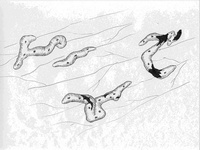|
 Willkommlangea reticulata Willkommlangea reticulata
SynonymsCienkowskia reticulata
Physarum reticulatum
BiostatusPresent in region - Indigenous. Non endemic
Images (click to enlarge)
Caption: Plasmodiocarps of Willkommlangea reticulata on a dead leaf. The one on the upper left is about 3 mm long.
Owner: S.L. Stephenson |
Article: Stephenson, S.L. (2003). Myxomycetes of New Zealand. Fungi of New Zealand. Ngā Harore o Aotearoa 3: xiv + 238 p. Hong Kong: Fungal Diversity Press.
Description: Fruiting body a stalked or nearly sessile sporangium, gregarious or clustered, short-cylindrical to obovate to subglobose, 0.6–1.6 mm in diameter and 2–4 mm tall. Stalk weak, often flattened, pale yellow or ochraceous, essentially representing an extension of the hypothallus. Hypothallus membranous, colourless, usually inconspicous. Peridium smooth, shining, brittle, consisting of three layers, the outer layer cartilaginous, pale yellow to ochraceous to chestnut brown or deep maroon, the middle layer calcareous, and the inner layer membranous, hyaline, dehiscence longitudinal or irregular. Capillitium of two types, the first consisting of slender, colourless, flattened tubules usually expanded at the junctions and the second represented by a series of transverse plates that divide the interior of the plasmodiocarp into segments. Spores black in mass, brown by transmitted light, with a paler area at one side, coarsely warted, 12–14 µm in diameter. Plasmodium orange or red.
Habitat: Forest floor litter and wood debris; sometimes fruiting on living plants.
Distribution: Cosmopolitan (Martin & Alexopoulos 1969) but not particularly common. First reported (as Cienkowskia reticulata) from New Zealand by Cheesman & Lister (1915), based on a specimen from Bay of Plenty. Also known from Northland, Auckland, and Dunedin (Rawson 1937).
Notes: This rather distinctive, but not especially common species is usually listed as Cienkowskia reticulata in earlier treatments of the myxomycetes. Many fruitings are characterized by the presence of "red spots" on the peridium.
|